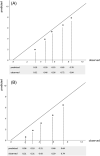Predicting survival in head and neck cancer: External validation and update of the prognostic model OncologIQ in 2189 patients
- PMID: 33960553
- PMCID: PMC8359959
- DOI: 10.1002/hed.26716
Predicting survival in head and neck cancer: External validation and update of the prognostic model OncologIQ in 2189 patients
Abstract
Background: Disclosing prognostic information is necessary to enable patients to make well-informed treatment decisions. OncologIQ is a prognostic model that predicts the overall survival (OS) probability in patients with head and neck squamous cell carcinoma (HNSCC). We aimed to externally validate and update the model with new prognostic factors and translate it to a clinically useful tool.
Methods: A consecutive retrospective sample of 2189 patients eligible for curative treatment of a primary HNSCC were selected. Discriminative performance was determined using the C-statistic.
Results: External validation showed systematic underestimation of OS in the new population, and reasonable discrimination (C-statistic 0.67). Adding smoking, pack years, BMI, weight loss, WHO performance, socioeconomic status, and p16 positivity to the recalibrated multivariable model, improved the internally validated C-statistic to 0.71. The model showed minor optimism and was translated in an online tool (www.oncologiq.nl).
Conclusions: The updated model enables personalized patient counseling during treatment decision consultations.
Keywords: head and neck cancer; prediction; prognosis; shared decision making; survival.
© 2021 The Authors. Head & Neck published by Wiley Periodicals LLC.
Conflict of interest statement
The authors declare that there is no conflict of interest that could be perceived as prejudicing the impartiality of the research reported.
Figures



References
-
- Bray F, Ferlay J, Soerjomataram I, Siegel RL, Torre LA, Jemal A. Global cancer statistics 2018: GLOBOCAN estimates of incidence and mortality worldwide for 36 cancers in 185 countries. CA Cancer J Clin. 2018;68(6):394‐424. - PubMed
-
- De Boer MF, McCormick LK, Pruyn JF, Ryckman RM, van den Borne BW. Physical and psychosocial correlates of head and neck cancer: a review of the literature. Otolaryngol Head Neck Surg. 1999;120(3):427‐436. - PubMed
-
- Barber B, Dergousoff J, Slater L, et al. Depression and survival in patients with head and neck cancer: a systematic review. JAMA Otolaryngol Head Neck Surg. 2016;142(3):284‐288. - PubMed
-
- Sehlen S, Lenk M, Herschbach P, et al. Depressive symptoms during and after radiotherapy for head and neck cancer. Head Neck. 2003;25(12):1004‐1118. - PubMed
Publication types
MeSH terms
LinkOut - more resources
Full Text Sources
Other Literature Sources
Medical

